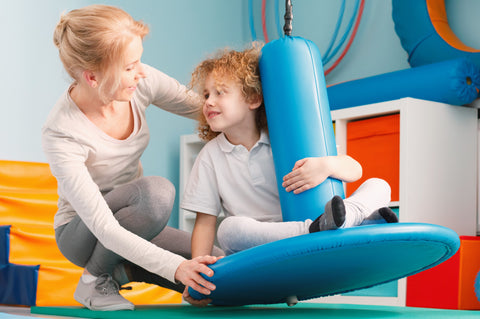
Meltdowns & Tantrums can be exhausting and challenging for both the caregiver & the child & they can be a time of high stress and emotions. Unfortunately, they can be hard to understand, can’t always be prevented and sometimes they are almost needed for a child to expel some of the pent up frustration they have been feeling. It can definitely challenge parenting especially when they happen in public spaces past when they are developmentally expected, 'Terrible Two's'.
Tantrums can be typical for toddlers & preschoolers especially when it relates to them wanting something specific & not getting it. During a tantrum, children still have some control of their behaviour and it will normally subside when they don't get the attention they are seeking or they get what they want. It's very emotions driven & emotional regulation can be difficult for this age group.
In contrast, a meltdown normally occurs when children feel overwhelmed & it can be hugely related to difficulties coping with sensory input in their environment. Therefore, 'meltdowns' or/and sensory overload are not isolated to just children & can equally happen to adolescents and adults. Having a 'meltdown' is not enjoyable & kids won't have them on purpose. Children & teenagers who have experienced 'meltdowns' have expressed feelings to me of "being out of control" during these times which often follow with feelings of gullt, remorse and low self-esteem. To learn more about sensory processing, I have completed a video series on my course which you learn more about by clicking here.
All of these strategies will depend on your child’s age, expressive & receptive language, sensory preferences, medical needs and diagnosis. Unfortunately, sometimes nothing will help & the meltdown just needs to happen.
I’m going to keep the strategies pretty general and hopefully one or two might help your child:
1. Try setting up an enclosed & safe space at home where they can retreat or be directed too. If your child gets volatile or self- destructive, you might decide to have very little in this space- just soft padding or a beanbag. Lots of houses don’t have the space for this so it might mean keeping one room clutter free.

2. Try prepping your child for outings & discuss possible scenarios using visuals if necessary. Give them a visual or safe word they can use when getting overwhelmed so you can either go somewhere quiet, go home or give them something to help regulate the external sensory input. I always recommend a sensory toolbox wherever you go with items that calm your child e.g blanket, suther, teddy, chewy, chewing gum, sunglasses, weighted vest, ear defenders, headphones and music. This may help reduce avoidance behaviours & meltdowns outside the home. If your child doesn't have the language or self-awareness to identify times when they feel 'stressed or overwhelmed', then it can be helpful to introduce these sensory tools at different intervals during the outing to reduce 'overload' while also trying to read body cues to signal they are becoming fidgety, overwhelmed or emotional unregulated.
3. If a certain setting always leads to a meltdown e.g shopping- maybe decide to do online shopping or go at a time when you are by yourself. If this isn’t possible, bring something your child can play with in the trolley or give them the list to tick off. Once again bring your 'sensory tool-kit' & depending on their age, get them involved in some 'heavy work' exercises like pushing the trolley or lifting items into the trolley.
4 Try to incorporate sensory calming & organising exercises throughout the day to help keep your child in a regulated state. Increase the intensity before leaving the house and have a plan in place for 'worst case scenario'. The activities that should be completed here are dependent on your child & their sensory needs/preferences. You should consult your OT to develop a individualised 'sensory diet'. If you don't have access to an OT, you can schedule an online consult with me by clicking here.

Hope these tips help,
Jess 😊